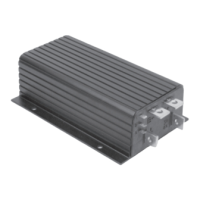31
Curtis PMC 1204/1205 Manual
TROUBLESHOOTING & BENCH TESTING
TEST
4 Check for controller output
4-A The first step is to measure the output drive voltage to the motor at
the controller’s M- terminal.
4-B Connect the voltmeter (+) lead to the controller’s B+ terminal.
Connect the voltmeter (-) lead to the controller’s M- terminal.
4-C Turn on the keyswitch with the forward/reverse switch in neutral,
and then select a direction and watch the voltmeter as you depress the
pedal. The voltmeter should read zero (or close to zero) before you
apply the pedal, and should read full battery voltage with the pedal
fully depressed. If it does not, the controller is defective and must be
replaced.
4-D The next step is to measure the current in the controller’s M- lead.
If you have a means of measuring this high dc current, such as a
shunt/meter setup or a clamp-on dc ammeter, use it. If not, we
recommend that you buy an inexpensive ammeter of the type that
is simply held against the wire being tested. These are readily
available at auto parts stores, and their accuracy is adequate for this
test.
4-E Turn on the keyswitch with the forward/reverse switch in neutral,
and then select a direction and watch the ammeter while depressing
the pedal.
4-F If you see no current flowing in the M- lead, the problem is an open
circuit in the motor or the wiring between the motor and the
controller. Check the forward/reverse switch. If your vehicle uses
contactors for reversing, check to see that they are operating and that
their contacts are closing. If these are okay, check the motor armature
and field for opens.
4-G If you do see a high current flowing in the M- lead, but the motor
does not turn, the problem is a short in the motor circuit, a miswired
motor, or a short in the controller’s internal plug diode. Test the plug
diode as follows:
1. Remove power by opening the battery circuit. Take
the cable off the controller’s A2 terminal.

